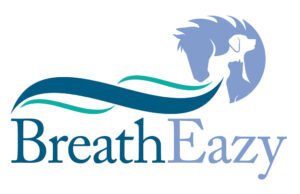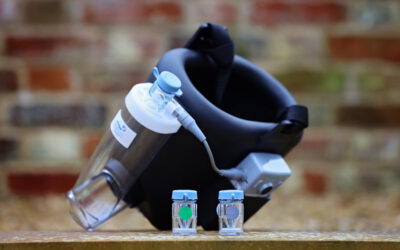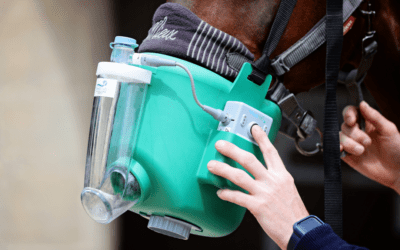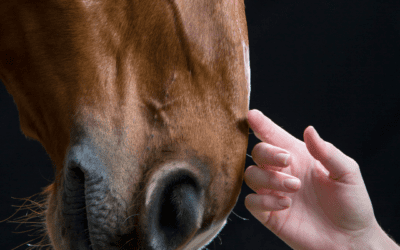Inhaled therapy for horses and ponies
Nebulisers and inhalers were initially used by humans to manage and treat respiratory illnesses, both in hospitals and at home. Indeed, many horse and pony owners will know someone who has needed an inhaler or nebuliser at some point or may even be familiar with using one themselves. The technology for equines is very similar to that used for humans, however, the challenge with horses and ponies is you cannot tell them to keep still when administering inhaled therapy! Finding a system which works for your horse or pony is very important – particularly when managing an ongoing chronic respiratory condition.
Why might my horse or pony need a nebuliser or inhaler?
If your horse or pony has been displaying symptoms such as coughing, increased breathing rate, nasal discharge, flaring of the nostrils, wheezing or abnormal lung sounds – and is diagnosed with a respiratory condition on veterinary examination – inhaled medication may be suggested to help manage their condition.
What conditions may a nebuliser or inhaler be useful for?
Nebulisers or inhalers can be used as part of the management of both acute and chronic respiratory illnesses in horses and ponies, just like they are in human patients. Some examples of conditions they may be recommended for include:
- Equine asthma – previously referred to as heaves, COPD (Chronic Obstructive Pulmonary Disorder) or RAO (Recurrent Airway Obstruction)
- Summer pasture-associated equine asthma (often triggered by grass or tree pollens)
- Inflammatory airway disease – typically seen in younger horses and ponies
Infectious pneumonia – most commonly viral or bacterial - EIPH (Exercise Induced Pulmonary Haemorrhage – most typically diagnosed in racehorses)
Nebulisers can be used to deliver different types of medication to the lungs and small airways, including bronchodilators (to reduce bronchospasm), anti-inflammatories i.e. steroids (to reduce inflammation) or antibiotics (to treat infection).
They can also be used to vaporise saline or non-drug therapies to optimise performance in competition horses e.g. racehorses and eventers, by reducing mucus and congestion of the airways, thereby improving their respiratory health and function. This can also help to avoid the challenges of the withdrawal/detection times of drugs used for these competition horses. Inhaled non-drug therapies can also be helpful in the ongoing management of respiratory disease in pleasure/non-competition horses once their initial symptoms have been controlled.
What are the benefits of inhaled therapy?
Systemic medications for the management of respiratory conditions are often relied upon in the early stages for convenience, especially if your horse or pony needs urgent alleviation of their symptoms. These medications are typically given in a horse or pony’s feed (powder, liquid or tablet form), or injected into the vein or muscle. Some of these drugs may have risks associated with them if used on an ongoing basis, or at high dosages. Veterinary surgeons will often warn of the possible unwanted side effects and risks of long-term or high-dose steroid treatments, particularly in patients who are overweight or suffering from Equine Metabolic Syndrome (EMS) – a condition similar to type 2 diabetes in humans. These patients may be at an increased risk of developing laminitis if steroids are used systemically over long periods or at high dosages; therefore the option to deliver concentrated medication such as steroids directly to the airways can reduce the dosages required, reduce the unwanted systemic effects and subsequently reduce the risk of laminitis developing.
Another reason a nebuliser may be suggested could be for drug-free management of a horse or pony’s respiratory health after an acute episode or flare-up has been controlled. Saline nebulisation, for example, can be helpful to prevent the build-up of mucus in the airways and may reduce the need for drug therapy or remove it altogether.
Is there anything else I should be thinking about in terms of management?
Other management changes should not be overlooked when using a nebuliser or inhaler. Such measures might include:
- maximising turnout (in line with any weight management strategies required, and not necessarily in cases where grass or tree pollen is exacerbating symptoms)
- maximising ventilation when stabled or indoors
- dust-free bedding
- dust and mould-free forage/feed
- encouraging exercise where possible
What benefit does medication directly delivered to the airways have over systemic medication?
A nebuliser or inhaler delivers concentrated medication to the lungs and small airways, therefore, is a more targeted way of treating respiratory disease than systemic medication, i.e. powders, liquid or tablets put in your horse or pony’s feed, or medication injected into your horse or pony’s vein/muscle. Drug dosages can be made smaller (and accurately adjusted) when using this targeted approach, therefore minimising the risk of unwanted side effects due to less drug being used and less systemic drug absorption (i.e. if delivered directly to the airways by a nebuliser or inhaler, the medication does not have to be absorbed into the bloodstream and distributed all over the body).
What is the difference between a nebuliser and an inhaler? And what are the benefits?
There are various options when it comes to choosing a nebuliser vs. an inhaler system. The most basic is a spacer/inhaler combination – the mask is placed over the horse or pony’s nostril and the meter-dose inhaler (MDI/puffer) is activated, which delivers vapour into the spacer chamber and the horse breathes in the vapour over 3-5 breaths per puff (this is likely to take 15-30 seconds). These systems have a low initial outlay, but as outlined above, can pose challenges if your horse is head-shy or fidgets during treatment. In addition, despite these systems being cheaper than a nebuliser to buy initially, MDIs can be comparatively more expensive than liquid medication which can be delivered via a nebuliser, so you may end up spending more money on the medication itself over long periods if managing a chronic respiratory condition.
Will my horse or pony tolerate a nebuliser or inhaler?
Nebulisation is based upon the traditional “steaming” method – where horses were encouraged to put their heads over a bucket of boiling water, often with a towel over their heads, to breathe in steam or saline vapour. Thankfully these days more user-friendly systems have been designed! Nebuliser systems based on a headcollar and muzzle system are generally very well tolerated by horses and ponies. Some individuals may require a little practice, patience, and some training to get them used to the routine, but most tolerate them well despite owner reservations. A reward-based approach is often helpful so that they see the nebuliser as a positive experience. If your horse or pony is head shy or very fidgety, a nebuliser system with a muzzle-based design is sometimes easier than a spacer/inhaler system, as the muzzle moves with them, rather than them being able to move their head away from a spacer mask at every opportunity! You can also walk the horse or pony around during nebulisation to distract them and increase their respiratory rate slightly to speed up the nebulisation process. This is not so easy with a spacer/inhaler system, as you are likely to need to hold, or at least steady, the spacer around the horse or pony’s nostril with one hand, operate the meter-dosed inhaler with the other hand – you would therefore need an assistant to walk your horse or pony for you and all be very well coordinated to make sure the medication was not wasted.
Deciding whether
Ultimately you should seek advice from your veterinary team to decide on the best management approach for treating any respiratory problem in your horse or pony, and ask for their input on whether a nebuliser or inhaler would be most suitable.





